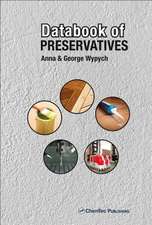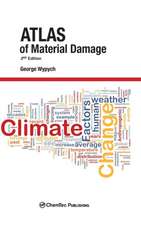Databook of Solvents
Autor George Wypychen Limba Engleză Hardback – 29 dec 2014
More than 300 of the most essential solvents are included, selected by expert George Wypych. Physical properties are included, as are health and safety considerations (such as carcinogenicity, reproduction/developmental toxicity, flammability) and first aid guidance. Emphasis is given in particular to cost-saving and more efficient replacements for more toxic solvents. Detailed information is also given for usage considerations, including outstanding properties, potential substitutes, features and benefits for each solvent and for which products the solvent is recommended.
- Includes more than 300 of the most essential solvents
- Practical information for use in the lab and the field, including recommended processing methods, recommended dosages, and potential substitutes
- Particular emphasis given to environmental considerations, enabling practitioners to find more efficient replacements for toxic solvents
| Toate formatele și edițiile | Preț | Express |
|---|---|---|
| Hardback (3) | 998.35 lei 2-4 săpt. | |
| ELSEVIER SCIENCE – 29 dec 2014 | 998.35 lei 2-4 săpt. | |
| ELSEVIER SCIENCE – 12 mar 2019 | 1342.64 lei 5-7 săpt. | |
| ELSEVIER SCIENCE – 24 apr 2024 | 1640.51 lei 5-7 săpt. | +149.91 lei 5-11 zile |
Preț: 998.35 lei
Preț vechi: 1097.09 lei
-9% Nou
Puncte Express: 1498
Preț estimativ în valută:
191.07€ • 198.95$ • 161.47£
191.07€ • 198.95$ • 161.47£
Carte disponibilă
Livrare economică 10-24 februarie
Preluare comenzi: 021 569.72.76
Specificații
ISBN-13: 9781895198805
ISBN-10: 1895198801
Pagini: 260
Dimensiuni: 152 x 229 x 40 mm
Greutate: 1.21 kg
Editura: ELSEVIER SCIENCE
ISBN-10: 1895198801
Pagini: 260
Dimensiuni: 152 x 229 x 40 mm
Greutate: 1.21 kg
Editura: ELSEVIER SCIENCE
Public țintă
Research and development, production chemists and engineers, environmental engineers, environmental professionals, industrial hygienists, legislators, medical professionals, civil engineers, university professors, students.Cuprins
1 Introduction
2 Information on the data fields
3 Solvents
3.1 Acids
3.2 Agriculture-based solvents
3.3 Alcohols
3.4 Aldehydes
3.5 Aliphatic hydrocarbons
3.6 Amines
3.7 Aromatic hydrocarbons
3.8 Chlorine-containing solvents
3.9 Esters
3.10 Ethers
3.11 Glycol ethers
3.12 Hydrofluorocarbons
3.13 Ionic liquids
3.14 Ketones
3.15 Miscellaneous
3.16 Phenols
3.17 Polyhydric alcohols
3.18 Sulfur-containing organic solvents
3.19 Supercritical fluids
3.20 Terpenes
2 Information on the data fields
3 Solvents
3.1 Acids
3.2 Agriculture-based solvents
3.3 Alcohols
3.4 Aldehydes
3.5 Aliphatic hydrocarbons
3.6 Amines
3.7 Aromatic hydrocarbons
3.8 Chlorine-containing solvents
3.9 Esters
3.10 Ethers
3.11 Glycol ethers
3.12 Hydrofluorocarbons
3.13 Ionic liquids
3.14 Ketones
3.15 Miscellaneous
3.16 Phenols
3.17 Polyhydric alcohols
3.18 Sulfur-containing organic solvents
3.19 Supercritical fluids
3.20 Terpenes





























